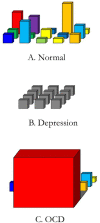Effects of Deep Brain Stimulation on the Lived Experience of Obsessive-Compulsive Disorder Patients: In-Depth Interviews with 18 Patients
- PMID: 26312488
- PMCID: PMC4552296
- DOI: 10.1371/journal.pone.0135524
Effects of Deep Brain Stimulation on the Lived Experience of Obsessive-Compulsive Disorder Patients: In-Depth Interviews with 18 Patients
Abstract
Deep Brain Stimulation (DBS) is a relatively new, experimental treatment for patients suffering from treatment-refractory Obsessive Compulsive Disorder (OCD). The effects of treatment are typically assessed with psychopathological scales that measure the amount of symptoms. However, clinical experience indicates that the effects of DBS are not limited to symptoms only: patients for instance report changes in perception, feeling stronger and more confident, and doing things unreflectively. Our aim is to get a better overview of the whole variety of changes that OCD patients experience during DBS treatment. For that purpose we conducted in-depth, semi-structured interviews with 18 OCD patients. In this paper, we present the results from this qualitative study. We list the changes grouped in four domains: with regard to (a) person, (b) (social) world, (c) characteristics of person-world interactions, and (d) existential stance. We subsequently provide an interpretation of these results. In particular, we suggest that many of these changes can be seen as different expressions of the same process; namely that the experience of anxiety and tension gives way to an increased basic trust and increased reliance on one's abilities. We then discuss the clinical implications of our findings, especially with regard to properly informing patients of what they can expect from treatment, the usefulness of including CBT in treatment, and the limitations of current measures of treatment success. We end by making several concrete suggestions for further research.
Conflict of interest statement
Figures
References
-
- Goodman WK, Price LH, Rasmussen SA, Mazure C, Fleischmann RL, et al. (1989) The Yale-Brown Obsessive Compulsive Scale: I. Development, use, and reliability. Archives of general psychiatry 46: 1006–1011. - PubMed
-
- Hamilton M (1959) The assessment of anxiety states by rating. British Journal of Medical Psychology 32: 50–55. - PubMed
-
- American Psychiatric Association (2000) Diagnostic and Statistical Manual of Mental Disorders, 4th edition DSM-IV-TR (text revision). Washington, DC: American Psychiatric Association.
-
- American Psychiatric Association (2013) Diagnostic and statistical manual of mental disorders, 5th edition Washington DC: American Psychiatric Association.
Publication types
MeSH terms
LinkOut - more resources
Full Text Sources
Other Literature Sources
Medical


